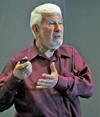Thought Leadership reinforces your strategic direction and enables you to stand out from the crowd. As I discussed last week, delivery is still an important element to being selected. The best strategy in the world is useless unless it is translated into action, consistently across all levels and functions.
Action comes from breaking down the strategic vision into goals and goals into projects and projects into actions and actions assigned to individuals and performed either specifically or by role. People can’t DO strategy but they can do well defined tasks.
When the pressure is on, the task becomes the focus. If it is properly defined to fit into the strategic direction, this should be an advantage not a problem. For example, in the recent (August, 2010) Cricket Test Series between England and Pakistan (now, sadly, to be remembered for all the wrong reasons), Jonathan Trott and Stuart Broad came together to form a world-record partnership to recover the England team from 102 for 7 wickets and a potentially match losing position to 434 for 8 wickets – and a position from which England went on to win the match.
Trott as a specialist batsman was the senior partner in their stand and as such would be expected to provide leadership and support. Broad, playing at no 9 and a specialist bowler, would not be expected to make 100, let alone the 169 runs he eventually made. Trott could be seen coaching Broad as the stand progressed. What was he saying?
Broad later said that Trott was advising him not to think about scoring a century or making a total from which England could win. “Just think about the next 5 runs and when they’re in the bag, think about the 5 after that” was apparently the advice.
I’d call what Trott was suggesting process goals. You have the overall goal and you have the direction. Now it is a matter of getting there from where you currently are. Process goals should always add momentum to the right direction and allow progress to be made to major achievement without overwhelm or deviation from the route. By breaking bigger goals down to process goals, you take away the indecision that larger goals create. There is one way to go, so it is easier just to go there.
As MD/CEO in an ideal world, you, with others, will set the goal and direction. Your team break down the goals into projects and their teams break the projects into tasks and perform them. For most CEOs, however, some involvement in process goals is likely but it isn’t inevitable. As your business grows, so the structure should support this process of translating strategy into action.
Because nothing happens unless you take action.
Brian Chernett is founder of The Academy for Chief Executives (ACE) – He has 43 years’ experience as managing director of private and public companies, including subsidiaries of Booker Bros McConnell, the Landmark Group, and several other major companies. Find out more at www.chiefexecutive.com.
The Academy community provides a great place to build your leadership skills and learn more about motivating and developing your people, and how to focus the top team for the good of your company. As the leading providers of experiential learning, the purpose of the Academy is to inspire leaders to achieve their dreams by sharing and learning from real life experiences.
